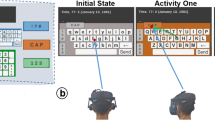Abstract
The Microsoft HoloLens 2 is a mixed reality (MR) headset that overlays virtual elements atop a user’s view of their physical environment. To input text, the device has the ability to track hands and fingers, allowing for direct interaction with a virtual keyboard. This is an improvement over the HoloLens 1 device, which required head tracking and single-finger air-tapping input. The present study evaluated the performance (speed and accuracy), perceived usability, mental workload, and physical exertion of one-handed and two-handed text entry. A sample of 21 participants (12 male, 9 female) aged 18–32 years typed standardized phrases presented in random order. Typing with two hands was faster and more preferred than one-handed input; however, this input method was also less accurate. Exertion in some body parts was also higher in the two-handed condition. Findings suggest that while two-handed text input was better than one-handed, there is room for improvement to approximate typing on a physical or mobile device keyboard.
Access this chapter
Tax calculation will be finalised at checkout
Purchases are for personal use only
Similar content being viewed by others
References
Milman, N.B.: Defining and conceptualizing mixed reality, augmented reality, and virtual reality. Distance Learning 15(2), 55–58 (2018)
Zheng, J.M., Chan, K.W., Gibson, I.: Virtual reality. IEEE Potentials 17(2), 20–23 (1998). https://doi.org/10.1109/45.666641
Brigham, T.J.: Reality check: basics of augmented, virtual, and mixed reality. Med. Ref. Ser. Q. 36(2), 171–178 (2017)
Browse All HoloLens Apps: https://www.microsoft.com/en-us/store/collections/hlgettingstarted/hololens. last accessed 25 Jan 2022
Derby, J.L., Rarick, C.T., Chaparro, B.S.: Text input performance with a mixed reality head-mounted display (HDM). Hum. Fac. Ergono. Soc. Ann. Meet. 63, 1476–1480 (2019)
Dudley, J.J., Vertanen, K., Kristensson, P.O.: Fast and precise touch-based text entry for head- mounted augmented reality with variable occlusion. ACM Trans. Comp.-Hum. Interac. 25(6), 1–40 (2018)
Sears, A.: Improving touchscreen keyboards: design issues and a comparison with other devices. Interac. Comp. 3(3), 253–269 (1991)
Hart, S.G., Staveland, L.E.: Development of NASA-TLX (task load index): results of empirical and theoretical research. Human Mental Workload, 139–183 (1988)
Brooke, J.: SUS - a quick and dirty usability scale. Usabi. Eval. Indus. 189–194 (1996)
Bangor, A., Kortum, P., Miller, J.: Determining what individual SUS scores mean: adding an adjective rating scale. J. Usability Stud. 4(3), 114–123 (2009)
Borg, G.: Borg’s Perceived Exertion and Pain Scales. Human Kinetics, Champaign, IL (1998)
Microsoft: https://www.microsoft.com/en-us/hololens/hardware . last accessed 23 Jan 2022
MacKenzie, I.S., Soukoreff, R.W.: Phrase sets for evaluating text entry techniques. In: CHI ‘03 Extended Abstracts on Human Factors in Computing Systems, pp. 754–755. Association for Computing Machinery, New York, NY, USA (2003)
Microsoft is working on Hololens 3: Consumer version. https://mspoweruser.com/microsoft-is-working-on-hololens-3-consumer-version/. last accessed 25 Jan 2022
Author information
Authors and Affiliations
Corresponding author
Editor information
Editors and Affiliations
Rights and permissions
Copyright information
© 2022 The Author(s), under exclusive license to Springer Nature Switzerland AG
About this paper
Cite this paper
Rickel, E., Harris, K., Mandile, E., Pagliari, A., Derby, J.L., Chaparro, B.S. (2022). Typing in Mid Air: Assessing One- and Two-Handed Text Input Methods of the Microsoft HoloLens 2. In: Chen, J.Y.C., Fragomeni, G. (eds) Virtual, Augmented and Mixed Reality: Design and Development. HCII 2022. Lecture Notes in Computer Science, vol 13317. Springer, Cham. https://doi.org/10.1007/978-3-031-05939-1_24
Download citation
DOI: https://doi.org/10.1007/978-3-031-05939-1_24
Published:
Publisher Name: Springer, Cham
Print ISBN: 978-3-031-05938-4
Online ISBN: 978-3-031-05939-1
eBook Packages: Computer ScienceComputer Science (R0)




